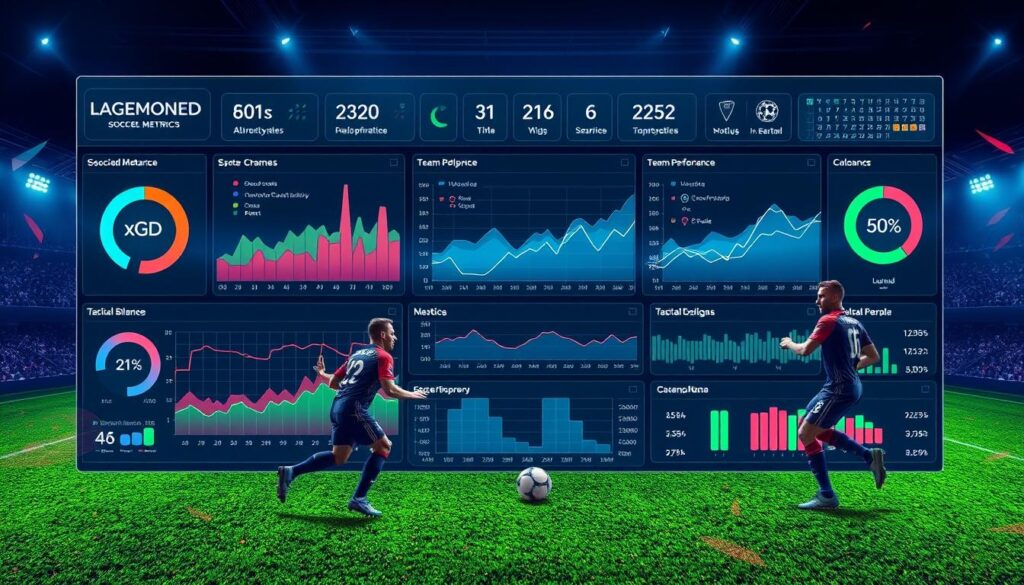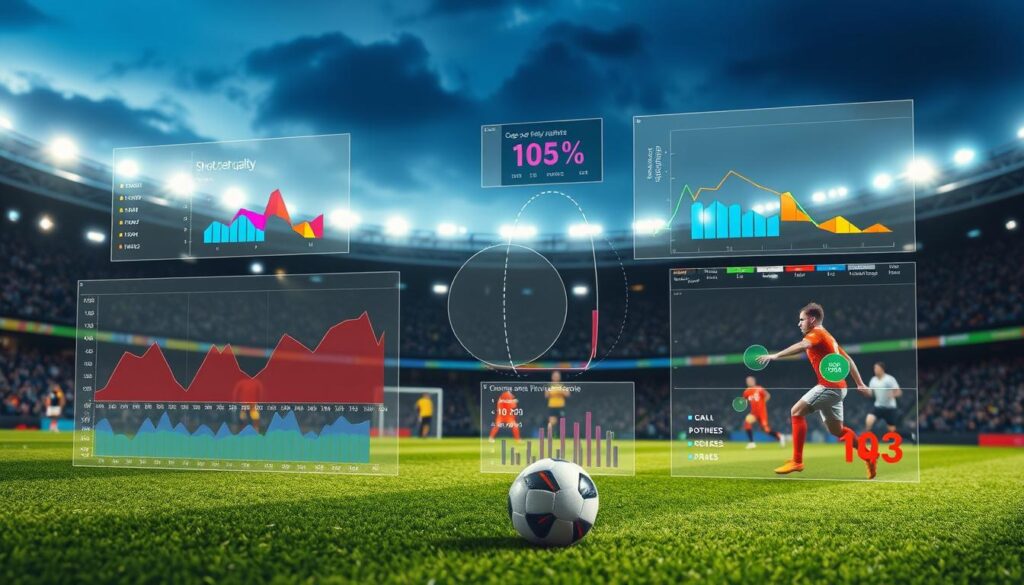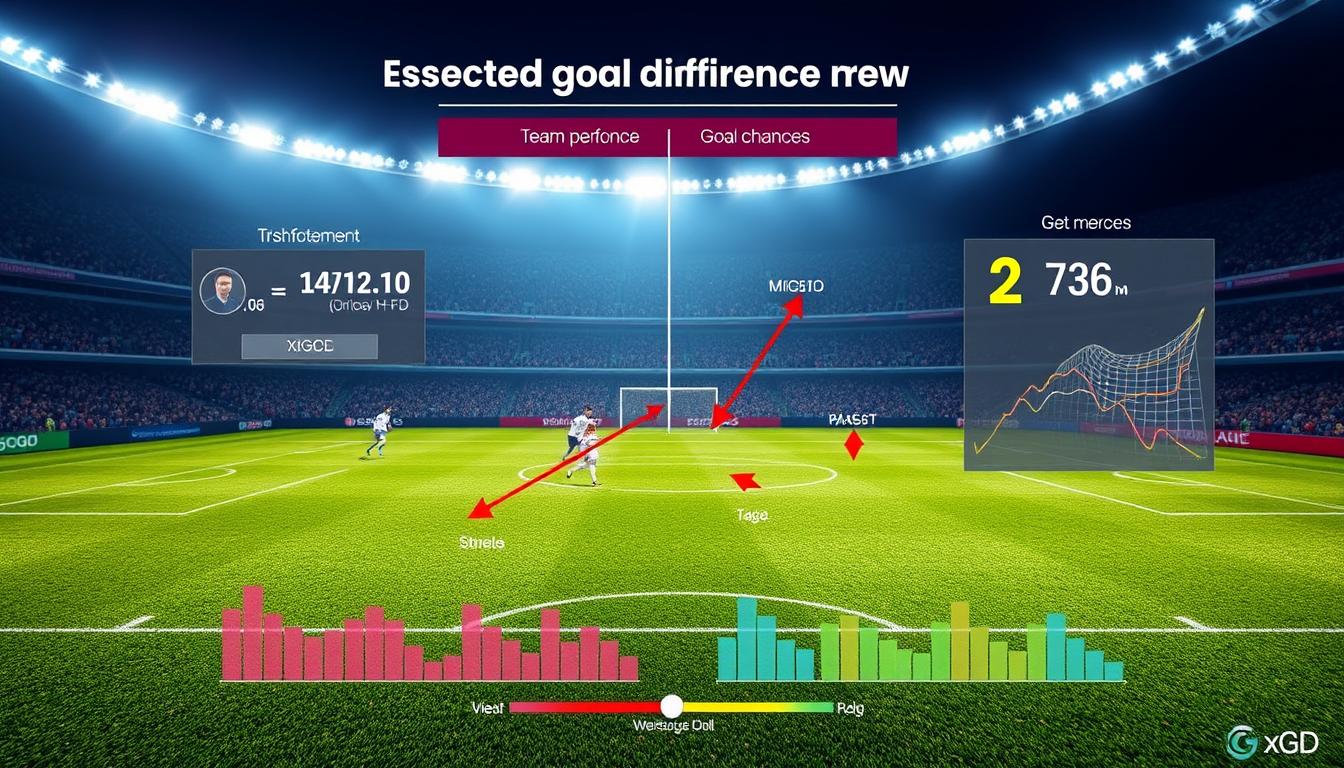In the realm of soccer analytics, a striking revelation surfaces: approximately one in ten shots culminate in a goal—a statistic that unveils the strategic depth of the sport’s unpredictable nature1. The advent of Expected Goal Difference (xGD) has revolutionized the evaluation of team performance, transcending the limitations of traditional metrics. This advanced metric scrutinizes not only the quantity but also the quality of chances created and conceded, delivering a nuanced comprehension of a team’s tactical equilibrium.
Conceived by analytics giants such as Opta and StatsBomb, xGD dissects the multifaceted aspects of team performance metrics, unveiling the underlying tactics in soccer and crafting a sophisticated narrative beyond the scoreline. Renowned clubs like Arsenal FC, Bayern Munich, and Ajax Amsterdam have embraced xGD to refine their tactical analysis, striving for an offensive-defensive equilibrium critical for contemporary success. This analytical approach has transformed soccer statistics into a sophisticated dialogue, where strategic insights are as vital as the talent on the field.
Recognizing these transformative shifts, soccer analytics programs globally are dedicated to condensing vast datasets into coherent, actionable insights. Visual tools such as xGD Heatmaps, Comparative Bar Graphs, and Time Series Line Charts facilitate the visualization of performance patterns, enabling teams and analysts to monitor and modify season trends. At the heart of this innovation lies a deep comprehension of Expected Goals (xG), Goal Probability Models, and Shot Quality, all converging into the overarching measure of xGD to assess Defensive and Offensive Efficiency.
Key Takeaways
- Expected Goal Difference (xGD) is a sophisticated soccer metric that evaluates team performance more holistically than the scoreline.
- xGD takes into account the quality of scoring opportunities, reflecting tactical nuances and team balance.
- Teams such as Arsenal FC and Bayern Munich leverage xGD for refined match performance evaluation and strategic forecasting.
- Visualizations like xGD Heatmaps enable teams to intuitively analyze complex soccer analytics data.
- Insights derived from xGD inform decisions on team cohesion, tactical adjustments, and identifying opponent weaknesses.
- Understanding xGD is essential for football analysts and teams aiming to gain a competitive edge.
Understanding the Basics of Expected Goals (xG) and xGD in Soccer
The advent of advanced soccer metrics, such as Expected Goals (xG) and Expected Goal Difference (xGD), has transformed the landscape of Soccer Data Analysis. These metrics provide a more refined perspective on team performance, transcending the limitations of traditional statistics.
Expected Goals (xG) quantifies the probability of a shot converting into a goal, considering variables like shot distance, angle, and assist type. It assigns a value between 0 and 1 to each shot, with higher values indicating a greater scoring likelihood. For instance, Sebastian Giovinco’s free kick against Chicago Fire had a low xG of 0.044, underscoring the minimal chance of scoring from that specific scenario2.
On the other hand, xGD, or Expected Goal Difference, is calculated by subtracting expected goals against (xGA) from expected goals for (xGF). This metric offers a more detailed view of a team’s efficiency, beyond mere goal totals. For example, Toronto FC’s positive xGD of 1.41 suggests an overperformance that might regress in subsequent matches2.
Statistical analysis reveals the alignment between a team’s actual performance and these expectations. Teams that outperform their xG often possess superior finishing skills or benefit from favorable conditions or luck. For instance, Manchester City’s 2021/22 Premier League season saw them outscoring their calculated xG, highlighting their proficient finishing3.
Further, xG in Soccer serves as a more accurate predictor of future performances than raw scores. Over time, teams tend to regress towards their xG, affirming its utility as a predictive tool. For example, despite Leicester City’s unexpected 2015-16 title, their xGD revealed a team performing above their expected level with a remarkable +14.71 xGD2.
Grasping and applying xG and xGD enables coaches, analysts, and fans to engage with Soccer Data Analysis on a more profound level. These Advanced Soccer Metrics not only enhance the evaluation of team and player performances but also refine tactical decision-making. This contributes to a more strategic and insightful appreciation of the game.
Analyzing the Impact of xG in Soccer on Match Outcomes
In the realm of Football Analytics, the Expected Goals (xG) metric has revolutionized traditional Soccer Statistics, delivering a more refined perspective on Match Performance Evaluation. By juxtaposing the xG value, which quantifies the quality of scoring opportunities, against actual goals scored, analysts can discern whether a team is exceeding or falling short of expectations. This nuanced analysis is indispensable for coaches seeking to refine their strategies and for sports analysts aiming to provide deeper insights into the game’s dynamics.
xG values, spanning from 0 to 1, are instrumental in assessing player efficacy and team tactics. Elevated xG values indicate substantial goal-scoring probabilities, facilitating teams in gauging their offensive prowess4. These metrics are not merely confined to post-match analysis but also enhance real-time Sports Analysis by spotlighting the efficacy of tactical maneuvers and set pieces such as corners and free kicks4.
The fusion of xG with advanced models, like the g+ model, significantly enhances its predictive prowess for forthcoming performances. Research indicates that the g+ model, which evaluates the strategic impact of specific plays, surpasses traditional metrics in predicting future Points Per Game (PPG)5. This synergy between xG and contemporary analytical frameworks facilitates a holistic examination of match outcomes, unveiling insights that transcend conventional statistics.
| Statistical Metric | Description | Impact on Match Analysis |
|---|---|---|
| xG (Expected Goals) | Measures the quality of chances on a scale of 0-1. | Assesses offensive and defensive performance4. |
| g+ model | Evaluates the strategic execution of plays. | Enhances predictive accuracy for future games5. |
Further, the real-time application of xG can sway tactical decisions during matches. The comprehension of xG values linked to various shot types or game scenarios can direct teams in refining their strategies to exploit opponent vulnerabilities4. This methodology not only elevates the tactical dimension of soccer but also propels Sports Analysis towards a more data-centric epoch.
The advancement of Football Analytics through tools like xG has fundamentally reshaped the evaluation of Soccer Statistics. It introduces a profound layer of insight, enriching discussions on match performance, enabling a more informed and strategic approach to the sport.
Expected Goal Difference, xGD, Soccer Analytics, Team Performance Metrics
In the realm of soccer analytics, the Expected Goal Difference (xGD) stands as a critical metric for evaluating a team’s performance. It encompasses both offensive and defensive prowess. Through xGD, analysts can discern the probable goal difference, a factor of utmost importance for strategic decision-making in match analysis and team evaluation.
Defining xGD and its Importance in Match Analysis
xGD is derived from the difference between Expected Goals (xG) and Expected Goals Against (xGA), highlighting a team’s attacking and defensive capabilities. The xG value is calculated based on the probability of each shot leading to a goal, taking into account factors such as shot location, angle, and type. It also considers the quality of the opposition’s attempts through xGA. A positive xGD signifies a team that consistently generates superior scoring opportunities than it concedes6.
An accurate xGD calculation offers a more stable indicator of a team’s performance compared to traditional goal difference. It accounts for the quality of chances created and conceded, not just the outcome. This metric is invaluable in soccer match analysis, aiding coaches and analysts in understanding whether a team is performing as expected or if tactical adjustments are necessary6.
Calculating xGD: The Methodology Behind the Metric
The methodology for calculating xGD involves several statistical data points aimed at refining its accuracy. Metrics such as non-Penalty xG (npxG) and xG On Target (xGOT) are critical in forming a complete xGD value7. Calculating xG per 90 minutes further aids in evaluating individual player contributions during a match, enabling the team to adapt its strategy based on ongoing performance trends6.
Integrating Expected Goals models, ranging from shot-based to possession and hybrid models, adds depth to the analysis. This offers various perspectives on each team’s gameplay and identifies areas for improvement6. This multi-faceted approach ensures xGD is not just a statistical measure but a dynamic tool for tactical analysis and strategic planning in soccer.
| Statistic | Description | Impact on xGD |
|---|---|---|
| xG per 90 minutes | Measures expected goals generated or conceded in a standard match span | Facilitates individual performance evaluation |
| xGOT | Assesses the probability of on-target shots scoring | Enhances the accuracy of shooting metrics within xGD formulations |
| xGOP vs. xGSP | Evaluates separately the xG from open plays vs. set plays | Distinguishes the effectiveness of different tactical implementations |
With the integration of synchronized position data6, xGD calculation transcends traditional metrics, tailoring analysis for more precise game strategies. This makes xGD an essential metric in bridging the tactical nuances with quantifiable analytics in soccer.
Decoding Team Performance Through Advanced Soccer Metrics
In the quest to unravel soccer’s intricacies, advanced soccer metrics such as Expected Goal Difference (xGD) unveil profound insights into team performance and strategic subtleties. These metrics serve as a robust framework for tactical analysis and predictive modeling, enabling teams and analysts to dissect the efficacy of tactics on the pitch.
How xGD Reflects Tactical Efficacy in Soccer
At its essence, xGD measures the disparity between chances created and those conceded, revealing which team was more likely to score, regardless of the actual score. This metric has emerged as a critical tool within soccer analytics, illustrating the tactical equilibrium or disequilibrium during a match. For instance, during the 1986 World Cup quarter-final, Maradona’s extraordinary ability to dominate and influence the game was evident, as he was central to Argentina’s goal-scoring opportunities8.
xGD’s Role in Predictive Modelling of Soccer Matches
Employing xGD in predictive modeling not only forecasts future match outcomes but also reveals expected season trends, essential for strategic planning. The metric showed that Argentina, with a high xGD in recent tournaments, consistently generated more goal-scoring opportunities than their opponents, facilitating better strategic decision-making for upcoming games9.
The shift from traditional stats to soccer analytics like xGD empowers teams to anticipate match results more accurately and tailor their strategies, ensuring a higher degree of preparedness and tactical adaptability.
| Metrics | 1986 World Cup Quarter-Final | 1989 UEFA Cup |
|---|---|---|
| xGD | 0.738 | 0.588 |
| Maradona’s Involvement (%) | 758 | 488 |
| Maradona’s Pass-to-Dribble Ratio (%) | 43.758 | 51.038 |
| Team xGD | Not Available | Higher Than Individual8 |
Tactical analysis through advanced metrics not only highlights individual prowess but also accentuates the collective strategic effectiveness, essential for a thorough evaluation of team performance.

Comparing xGD with Traditional Soccer Statistics
The realm of Soccer Data Analysis has undergone a transformative shift, elevating metrics such as xGD to prominence. This metric aligns more intimately with the sport’s fluid dynamics, diverging from the static nature of Traditional Metrics like goals scored and conceded. xGD, or Expected Goal Difference, integrates shot quality and scoring probability, rendering a more refined depiction of a team’s prowess.
Unlike Traditional Metrics in Soccer Statistics, which measure performance through direct match outcomes, xGD probes deeper, considering the quality of opportunities created10. This metric’s accuracy is underscored by its validation through advanced models, such as the Octosport xG model, which exhibits a remarkably low log-loss value10.
Through a detailed examination, we can discern the disparity between xGD and conventional statistics in assessing team and player performance:
| Team/Player | xGD/90 | Traditional Goals Scored |
|---|---|---|
| Bayern Munich | +1.92 | 54.3 |
| Barcelona | +1.16 | 51.4 |
| Liverpool | +0.91 | 48.9 |
| Inter | +1.28 | 46.4 |
| Newcastle | +0.23 | 45.5 |
The xGD values reveal the latent capacity of each team to convert their created chances into actual goals, uncovering insights that traditional metrics often miss11.
Further, xGD analysis delves into specific scenarios like set plays, open-play situations, and penalty kicks, furnishing strategic insights vital for Soccer Statistics and Soccer Data Analysis. For example, frameworks that dissect xG into components like xG Set Play (xGSP) or xG Open Play (xGOP) enhance our comprehension of a team’s offensive and defensive prowess across different game phases10.
In summary, xGD offers a holistic framework that combines the predictive efficacy of xG with actual match outcomes. This framework empowers analysts, coaches, and enthusiasts to gain a more complete understanding of team performance. As we explore the essence of Soccer Data Analysis, xGD exemplifies the transformative impact of contemporary statistics on traditional sports analytics11.
The Application of xGD in Professional Soccer
The advent of soccer analytics has precipitated an era where metrics such as Expected Goal Difference (xGD) transcend mere supplementary figures, becoming integral to tactical analysis in professional soccer. European soccer clubs, at the vanguard of this transformation, have seamlessly integrated sophisticated xGD applications into their tactical frameworks. This integration has revolutionized how teams assess performance and strategize, marking a paradigm shift in the sport’s analytical landscape.
xGD in European Clubs: Case Studies from Manchester City FC, Bayern Munich, and Ajax Amsterdam
The strategic deployment of soccer analytics, with xGD at its core, has become a defining feature of top-tier European soccer clubs. Manchester City FC, Bayern Munich, and Ajax Amsterdam exemplify this trend, leveraging xGD to enhance their tactical acumen. This approach enables them to strike a delicate balance between offensive aggression and defensive solidity. The insights derived from xGD applications within these clubs are instrumental in refining team cohesion, facilitating tactical adjustments, and identifying exploitable weaknesses in opponents.
Manchester City FC, renowned for its analytical prowess under Pep Guardiola, employs xGD to continually refine its tactics. Research indicates that xGD models, by quantifying the quality of shots, exhibit remarkable accuracy, with team performance often mirroring xGD predictions12. This precision empowers the club to make informed decisions regarding player selection and strategic planning, ensuring sustained on-field success.
In the Bundesliga, Bayern Munich utilizes xGD metrics not only for match preparation but also for tracking season trends and player development. The correlation between xGD per shot and Expected Points serves as a testament to xGD’s predictive power in match outcomes, underscoring its role in crafting winning strategies13.
Ajax Amsterdam’s utilization of xGD exemplifies its value in scouting and player development within a competitive league. The Dutch club’s ability to harmonize traditional soccer expertise with innovative metrics like xGD enables a dynamic approach to match analysis and player performance evaluation.
The application of xGD in professional soccer transcends mere numerical analysis, embodying a deeper understanding of game dynamics. As xGD continues to evolve, its significance in soccer analytics grows, equipping teams with the necessary tools to maintain a competitive advantage in the rapidly evolving world of professional soccer.
Real-World Examples of xGD in Soccer
The evolution of soccer analytics necessitates a profound comprehension of Expected Goal Difference (xGD) application. Arsenal FC, Ajax Amsterdam, and Bayern Munich have successfully incorporated xGD into their strategic frameworks, transforming their approach to game analysis. This metric is now indispensable for refining both offensive and defensive strategies through meticulous performance evaluations and strategic match preparation.
Arsenal FC
Arsenal FC’s dedication to data-driven strategies is exemplified through its utilization of xGD. This metric enables the team to assess the efficacy of their attacking formations and make strategic defensive adjustments. For instance, during games where xGD fluctuated significantly, the team’s ability to adapt tactically was critical in achieving a better balance between offense and defense.
Ajax Amsterdam
Ajax Amsterdam’s reliance on xGD as a core metric for evaluating player and team performance during matches is noteworthy. The club’s data analysts meticulously examine xG, xGA, and xGD to optimize their tactical approaches, ensuring competitiveness in both domestic and European competitions. These detailed analyses are instrumental in tailoring training programs that enhance individual and collective performance.
Bayern Munich
Bayern Munich’s utilization of xGD showcases their technical acumen and tactical finesse. By integrating xGD into their match analysis, they can identify areas for improvement and opportunities to exploit. This continuous refinement is essential for maintaining their status as a European football powerhouse, adapting to the ever-changing landscape of football tactics.
The adoption of xGD by these clubs highlights its significance in contemporary soccer analytics. By employing this metric, teams gain a deeper understanding of game dynamics, facilitating the development of responsive and resilient strategies.
The ascendance of Real-World Soccer Analytics is exemplified by the strategic deployment of xGD Examples by elite clubs such as Arsenal FC, Ajax Amsterdam, and Bayern Munich. These instances not only showcase the sophistication of current analytics practices but also foreshadow the future impact of advanced metrics on soccer strategy and performance analysis141516.
xGD’s Influence on Soccer Data Analysis Programs
In the contemporary soccer realm, the impact of Expected Goal Difference (xGD) on the development of soccer data analysis software is both significant and transformative. These sophisticated software applications integrate xGD, delivering profound insights that profoundly influence both strategy formulation and game interpretation. For soccer analysts, coaches, and aficionados, the depth of analysis afforded by these tools is absolutely critical17.
The predictive prowess of xGD, most evident in scenarios where the goal difference is minimal, highlights its value in software designed for tactical analysis and tracking of season trends. Research reveals that xGD retains its predictive strength for forecasting team-season outcomes, even in closely contested matches17.
Advanced soccer analytics tools, driven by xGD, have significantly redirected focus toward the meticulous evaluation of match performance. For example, the detailed scrutiny of scenarios with a tight goal difference reveals minimal variance compared to broader game scenarios, underscoring the all-encompassing nature of xGD as a metric17.
The integration of xGD in soccer data analysis programs also encompasses the visual representation of data through xGD heatmaps and comparative bar graphs. These visual aids offer rapid and intuitive assessments of team performances and player contributions across various game states17.
Further, the insights into team cohesion and the capacity to make tactical adjustments mid-game are significantly bolstered by the use of xGD-focused analytics. This methodological approach in software programs ensures that every tactical decision is grounded in robust data. This facilitates a deeper comprehension of both offensive efficiency and defensive tactics17.
These advanced functionalities underscore the vital role of xGD in soccer data analysis programs. As the domain of soccer analytics continues to evolve, the precision and comprehensiveness offered by xGD will undoubtedly remain at the heart of the analysis and comprehension of the beautiful game17.
Creating Effective Visualizations for xGD Data
The application of xGD Heatmaps, Comparative Bar Graphs, and Time Series Line Charts in soccer analytics presents unique benefits. These visualization methods are essential for deciphering complex data, shedding light on tactical efficacy and seasonal patterns.
Interpreting xGD Heatmaps and Comparative Bar Graphs
xGD Heatmaps are indispensable for identifying on-pitch locales where teams consistently generate high-quality opportunities or concede shots. This dual functionality elucidates both offensive capabilities and defensive weaknesses. For instance, Al Hilal’s heatmap in the Saudi Pro League reveals concentrated high-quality chance creation in the final third, aligning with their league-leading positive xGD of +518.
Comparative Bar Graphs facilitate a straightforward comparison of xGD across teams, enabling swift assessments of team performance and league standings. An insightful graph could depict Al Ittihad’s efficiency, with a +1.5 xGD marginally trailing its actual goals scored figure of 24 against an xG of 22.518. Such a visual clearly illustrates the minute yet critical difference in scoring efficiency that often decides match outcomes.
Utilizing Time Series Line Charts to Track Team xGD Trends
Time Series Line Charts are adept at displaying xGD trends over the season, illustrating how teams evolve or regress strategically. By overlaying multiple seasons, these charts unveil patterns of improvement or decline. For example, analyzing different seasons, one could discern Arsenal’s varying tactical approaches, resulting in fluctuating xGD metrics, indicating managerial changes19.
A deeper dive into data visualization can be demonstrated through a focused chart analysis:
| Team | Average xGD (Season) | Goals Scored | Goals Allowed |
|---|---|---|---|
| Bayern Munich | +2.1 | 74 | 31 |
| Al Hilal | +5 | 57 | 22 |
| Al Ittihad | +1.518 | 24 | 19 |
| Arsenal | -0.519 | 38 | 49 |
The incorporation of xGD visualizations into performance analysis not only solidifies comprehension of metrics like xGD but also enriches discussions on player and team development, strategic planning, and game preparation. As teams and analysts embrace these tools—such as Arsenal monitoring adjustments in their tactical setup19—they lay the groundwork for more data-driven decisions, profoundly influencing competitive outcomes.
Key Elements That Influence xGD: Shot Quality and Goal Probability Models
In the domain of soccer analytics, grasping the intricacies of Expected Goal Difference (xGD) is imperative for augmenting team performance and tactical maneuvers. Among the key elements of xGD, shot quality and goal probability models emerge as critical components. These models evaluate each shot through metrics such as distance, angle, and the prevailing game situation at the shot’s execution.
Shot quality considers the probability of a shot converting into a goal, encompassing factors like shot distance and angle, the preceding play type, and the shooting body part. This thorough evaluation enables the prediction of scoring opportunity values in soccer20. Importantly, the analysis of shot quality via models quantifies offensive efficacy and refines defensive tactics.
Concurrently, goal probability models leverage historical data to forecast the probability of shots becoming goals. These models are further refined by incorporating player quality metrics, as indicated by Elo ratings spanning from sub-1650 for lower-tier teams to over 1850 for elite teams like Manchester City20. Such meticulous modelling aids teams in strategizing and making informed decisions during critical match moments.
| Feature | Importance (SHAP Value) |
|---|---|
| Shot Distance | Most Influential in Model |
| Elo Rating | Less Influential on Average |
| Brier Skill Score | 0.1058 (Base xG Model) |
The integration and analysis of these soccer analytics are vital for coaches and analysts aiming to quantitatively comprehend player and team performances and forecast future outcomes. The strategic deployment of goal probability models and shot quality assessments in soccer analytics ensures that every coaching decision is substantiated by data-driven insights, fostering increasingly sophisticated tactics and game plans20.

By meticulously examining elements such as goal probability and shot quality, teams can significantly influence their tactical approaches, player evaluations, and match outcomes. This underlines the critical role of shot quality and goal probability models in formulating winning strategies in professional soccer.
Utilizing xGD to Uncover Team Cohesion and Tactical Adjustments
The intricacies of Soccer Team Analysis are profound, with team cohesion and tactical adjustments playing critical roles in determining game outcomes. xGD (Expected Goal Difference) emerges as a key metric within this analytical framework. It gauges the alignment between a team’s actual and expected performance, effectively measuring their offensive prowess and defensive solidity.
RB Global’s tactical metamorphosis is emblematic. In the 2021 campaign, they achieved an xGD of 10.37, securing a fifth-place ranking in the league, indicative of a formidable defensive posture complemented by potent forward play21. This marked a significant leap from their 2020 standing, which was amongst the league’s bottom five21. The following season, RB Global maintained an xGD of 9.61, solidifying their sixth-place position21. This data highlights the team’s steadfast tactical approach, coupled with incremental enhancements in both offensive and defensive synergy.
Further, the Tuchel era at Chelsea offers valuable insights into the tactical nuances of xGD. Under Tuchel, Chelsea’s defensive acumen improved, with a +1 xG difference per game. This was achieved through a tactical shift to a 3-4-3 formation from Lampard’s 4-3-3, coupled with a more stringent defensive stance, leading to a reduction in opposition shot volume and an increase in defensive actions22.
Strategic analysis is reinforced by examining teams like Cerezo Osaka across different leagues. Cerezo Osaka’s defensive rigour resulted in an xG difference of 0.12 and 26 league points23, underscoring the efficacy of consistent defensive tactics and team cohesion.
| Season | xGD | League Points | Goals Scored |
|---|---|---|---|
| 2021 RB Global | 10.37 | 48 | 39 |
| 2022 RB Global | 9.61 | 53 | 48 |
| Current Season Cerezo Osaka | 0.12 | 26 | 23 |
Such data-driven insights underscore the xGD’s utility in pinpointing areas for tactical refinement or the preservation of proven strategies. Through xGD, coaches and analysts can fine-tune their tactics to align with their team’s operational strengths and weaknesses, optimizing both offensive efficiency and defensive efficiency. The capacity of xGD to integrate diverse performance metrics positions it as a foundational element in contemporary Soccer Team Analysis.
Exploring the Adaption of xGD by Football Analytics Professionals
The evolution of Soccer Metric Adoption has witnessed a marked shift, with xGD gaining traction among football analytics professionals. This metric’s precision in capturing team performance and tactical subtleties, often overlooked by traditional metrics, has driven its adoption. Arsenal FC and Bayern Munich, for instance, are utilizing this tool to enhance their tactical analysis, striving for a more balanced offensive-defensive strategy and more accurate match performance evaluation.
Advanced analytics have revealed that Manchester City’s performance, as predicted by xGD, closely aligned with actual results, with the team exceeding expected goal difference, highlighting their strategic acumen24.
The integration of xGD into analytical frameworks offers a profound visualization of trends, enabling clubs and analysts to craft more effective strategies. The deployment of xGD Heatmaps and Time Series Line Charts not only visualizes data but also furnishes actionable insights, facilitating teams in tracking their performance and making informed decisions throughout the season.
| Team | Projected xGD | Actual Goal Difference | League Position |
|---|---|---|---|
| Manchester City | +69 | +79 | 1st |
| Liverpool | +40 | +46 | 4th |
| Watford | +26 | -20 | 13th |
| Bournemouth | +19 | -16 | N/A |
| Wolverhampton Wanderers | N/A | N/A | N/A |
| Arsenal | N/A | N/A | N/A |
Chelsea, under Thomas Tuchel’s stewardship, has seen a notable decrease in conceded xG, reflecting Tuchel’s intensified defensive focus25. The variability in player performance, such as Hakim Ziyech’s underutilization and Mason Mount’s strategic deployment, highlights the real-world challenges and adaptability required in Soccer Metric Adoption.
The incorporation of xGD into analytical frameworks by Football Analytics Professionals offers a more nuanced, predictive insight into game dynamics. This shift towards data-driven decision-making transcends simple league standings and individual match outcomes, fostering a more informed approach to the sport.
Deriving Match Performance Evaluation Insights Using xGD
In the domain of soccer performance analysis, the advent of expected goal difference (xGD) has transformed our methodologies for assessing match outcomes and tactical deployments. By scrutinizing the discrepancies between anticipated and actual goals, teams can ascertain their offensive prowess and defensive resilience. This metric is indispensable not only for post-match dissections but also for strategizing future tactical maneuvers.
For instance, Arsenal’s propensity for surpassing their xGD offers insights into the sustainability of their performance or the necessity for tactical reassessment26. On the contrary, Juventus’s trend of underestimating their expected goals reveals underlying issues in their finishing capabilities, critical for strategic recalibrations26.
Analytical tools in soccer employ the xGD metric to elucidate a team’s season-long performance trends and game-by-game outputs. For example, Chelsea’s lower expected goals against total not only exemplifies their defensive acumen but also facilitates strategic planning against high xG teams26.
Further, by leveraging the power of xGD insights, analysts can forecast a team’s likelihood to sustain, enhance, or deteriorate their goal-scoring and conceding trajectories, vital for mid to long-term strategic planning.
| Team | xG Game Output | Actual Goals | xGD |
|---|---|---|---|
| Liverpool | 2.5 | 3 | 0.5 |
| Manchester City | 2.3 | 2 | -0.3 |
| Arsenal | 1.8 | 2 | 0.2 |
| Chelsea | 1.0 | 1 | 0 |
The data illustrates performance variations, with teams like Liverpool displaying positive xGD, indicating an excess of goals over expectations. In contrast, Manchester City exhibits a negative xGD, possibly indicating underutilization of created opportunities26.
Such evaluations utilizing xGD insights are instrumental in match performance assessments, providing a more refined comprehension than traditional metrics. This renders xGD a quintessential analytical tool in soccer, enabling teams to identify strengths and weaknesses with unparalleled precision. By integrating these insights into strategic planning, teams can refine their tactical responses, optimizing both offensive and defensive setups.
In summary, the strategic incorporation of xGD into soccer performance analysis empowers professionals to interpret past performances and forecast future outcomes with heightened accuracy. This analytical methodology not only measures but also instructs, solidifying its role as a cornerstone in contemporary soccer analytics.
xGD’s Role in Identifying and Exploiting Opponent Weakness
In the domain of soccer analytics, Expected Goal Difference (xGD) has evolved into a critical instrument for Opponent Weakness Identification and Exploiting Weaknesses. This metric sheds light on underperforming areas, enabling coaches to craft strategies that effectively counter these vulnerabilities during Tactical Match Preparation.
For example, Leicester City’s 2015-16 Premier League campaign exemplifies the efficacy of a positive xGD in signaling effective offensive and defensive tactics, despite statistical predictions of lower performance2. TFC’s minor xGD of 1.41 indicates fluctuations in actual versus expected performance, underscoring the need for tactical refinements2.
On the other hand, Al Ahli’s dismal xGD of -5 in the Saudi Pro League reveals significant shortcomings in converting expected goals into actual scores, pinpointing specific areas for strategic overhaul and personnel adjustments18.
This xGD’s Role emerges as a strategic asset, guiding teams such as Al Ittihad under Laurent Blanc to leverage analytical insights for on-field advantages and enhanced win ratios18. It not only highlights weaknesses but also showcases how teams like Al Hilal capitalize on strong offensive plays, maintaining a high xGD that reflects their scoring efficiency18.
| Team | xG | Goals Scored | xGD |
|---|---|---|---|
| Chicago Fire | 20.62 | 25 | 4.382 |
| TFC | 21.48 | 25 | 1.412 |
| Al Hilal | 22 | 22 | 518 |
| Al Ittihad | 22.5 | 24 | 1.518 |
The strategic deployment of xGD enhances Match Performance Evaluation and plays a vital role in Season Trend Tracking and Offensive-Defensive Balance. By dissecting xGD, teams can refine their training and match tactics, leading to more precise and effective engagement strategies on the pitch.
Ultimately, the incorporation of xGD into soccer analytics transcends its role as a diagnostic tool, becoming a catalyst for adaptive and proactive tactical planning. This not only elevates a team’s immediate game-day performance but also fosters their long-term strategic evolution.
The Future of Soccer Analytics with xGD and Beyond
The realm of soccer analytics is undergoing a perpetual transformation, with a heightened focus on the Future of Soccer Analytics, Evolving Models, and the integration of AI in Soccer and Machine Learning. The expansion of analytics, such as expected goal difference (xGD), not only deepens our comprehension of team performance but also catalyzes the advancement of more refined Performance Metrics.
Evolving Models and the Next Generation of Team Performance Metrics
Recent studies underscore the significance of xGD as a critical metric in soccer analytics. For example, “Expected Goals” (xG) is increasingly regarded as the superior predictor of future team performanceanalyzing league outcomes with a robust dataset spanning 2018 to 202427. Methodological adaptations, such as assessing gamestate-aware metrics, reveal minimal differences in predictive efficacy when utilizing full-match xGD ratios versus specific gamestates—indicating that holistic perspectives yield comparable predictive insights27.
The evolution of analytics methodologies aims to not only track but also forecast tactical adjustments and team cohesion effectively. This development suggests a paradigm where machine learning algorithms are central, parsing vast data arrays to distill actionable insights, refining both offensive and defensive strategies28.
The Integration of AI and Machine Learning in Soccer Analytics
The integration of AI and Machine Learning into soccer analytics marks a transformative leap. AI technologies enable a more detailed analysis of gameplay, allowing teams to optimize strategies in real-time. Innovations such as predictive algorithms are being employed to enhance decision-making processes, leveraging historical data to forecast future outcomes with greater accuracy.
For instance, advanced models have evaluated a team like Arsenal, highlighting their efficiency in creating scoring opportunities and stifling opposition plays in evenly matched scenarios, underscoring the effectiveness of AI in refining team tactics and deployment28. Teams like Chelsea and Manchester City are evaluated not only on raw performance metrics but also on adjusted metrics that consider the strength of schedule and actual gameplay contexts, providing a more detailed insight into their tactical frameworks28.
Looking ahead, the future of soccer analytics with xGD and beyond will increasingly rely on the synthesis of traditional approaches and advanced AI-driven models. This partnership promises to unlock new dimensions in soccer analysis, translating complex data into strategic knowledge that can significantly tilt competitive advantages in favor of those who effectively harness these evolving tools.
Conclusion
In the analytical domain of contemporary football, the Expected Goal Difference (xGD) has ascended to a critical metric, delivering a profound insight into team performance and tactical alignment. Through the strategic examination of xG and xGD, entities such as Arsenal FC, Bayern Munich, and Ajax Amsterdam have refined their competitive advantage, cultivating both offensive efficacy and defensive acumen. The embracement of such methodologies by Opta, StatsBomb, and a multitude of forward-thinking football analysts has significantly augmented the objective evaluation of team dynamics and seasonal performance trends29.
The incorporation of advanced visualizations, encompassing xGD heatmaps and time series line charts, has transformed the methodology through which coaches, analysts, and aficionados interpret match performance evaluations and identify tactical adjustment opportunities. These innovations in soccer analytics summary and xGD findings transcend mere academic pursuits; they are instrumental in discerning team cohesion and exploiting adversaries’ vulnerabilities, solidifying soccer analytics as an indispensable asset in today’s data-driven sporting landscape.
As we contemplate the horizon of the sports industry, the forthcoming influence of xGD, coupled with ongoing developments in AI and machine learning, heralds an era of transformative evolution. The prospect of performance analysis conclusions derived from increasingly detailed and predictive datasets heralds an exhilarating epoch for those engaged in the beautiful game. With such profound insights at our command, the narrative of soccer analytics continues to evolve, enriching the collective comprehension of professionals, entrepreneurs, and innovators committed to leveraging actionable knowledge for competitive superiority and the passion for the sport30.
FAQ
What is Expected Goal Difference (xGD) in soccer analytics?
How does xGD differ from traditional soccer statistics?
How is xGD calculated, and what factors contribute to its accuracy?
Why is xGD considered an important metric for match analysis?
Can xGD be used to evaluate player performance?
How do soccer analytics programs incorporate xGD?
What are the benefits of visualizing xGD data?
How do shot quality and goal probability models impact xGD?
In what ways has xGD impacted professional soccer clubs?
How does xGD assist in predictive modeling of soccer matches?
What is the future of soccer analytics involving xGD?
How do football analytics professionals utilize xGD?
How is xGD applied in tactical match preparation?
Source Links
- Theory of Soccer Pt. 3: On Account of Bounce – https://absoluteunit.substack.com/p/theory-of-soccer-pt-3-balls-bouncing
- Understanding expected goals and how they impact Toronto FC – https://www.nytimes.com/athletic/67687/2017/06/16/understanding-expected-goals-and-how-they-impact-toronto-fc/
- Expected goals: explained – Coaches’ Voice – https://learning.coachesvoice.com/cv/expected-goals-xg-explained/
- xG Data – Sportmonks – https://www.sportmonks.com/football-api/xg-data/
- Breaking Goals Added — American Soccer Analysis – https://www.americansocceranalysis.com/home/2020/5/12/breaking-goals-added
- What is Expected Goals (xG) and How is it Changing the Way We Analyze Football? – https://medium.com/@marin11amf11/what-is-expected-goals-xg-and-how-is-it-changing-the-way-we-analyze-football-3e40dfe80936
- XG explained – Sportmonks – https://www.sportmonks.com/blogs/xg-explained/
- Metrics & Explainers Archives – Page 3 of 8 – Hudl Statsbomb | Data Champions – https://statsbomb.com/articles/soccer/metrics-and-explainers/page/3/
- COPA AMERICA 2024 -Argentina’s record and the tale of two strikers: Lautaro and Oluwaseyi – https://www.linkedin.com/pulse/copa-america-2024-argentinas-record-tale-two-strikers-3bkif
- The Power of Football Expected Goals – https://octosport.medium.com/the-power-of-football-expected-goals-0d4849a5ff1b
- Quantifying Success: Analysing Key Metrics in Football Performance Using Advanced Stats – Fantasy Football 247 – Premier League Tips – https://fantasyfootball247.co.uk/analysing-key-metrics-in-football-performance-using-advanced-stats/
- What is xG? How is it calculated? | Hudl Statsbomb | Data Champions – https://statsbomb.com/soccer-metrics/expected-goals-xg-explained/
- Shot quality and results in football – Soccerment – https://soccerment.com/shot-quality-and-results-in-football/
- Random Notes — Ancelotti’s renewal, what to make of xGD, Arsenal/Emery and other thoughts. – https://medium.com/@mcgboye/random-notes-ancelottis-renewal-what-to-make-of-xgd-arsenal-emery-and-other-thoughts-a0e2d73765d8
- Why Certain Teams Should Focus on the Counterattack – https://sites.northwestern.edu/nusportsanalytics/2019/01/17/why-certain-teams-should-focus-on-the-counterattack/
- Visualizing the Premier League So Far, Part 1: Overview with xPts Tables and xG Plots – http://ryo-n7.github.io/2019-11-21-visualize-EPL-part-1/
- Expected goals, gamestate, and predictiveness – Tony’s Blog – https://tonyelhabr.rbind.io/posts/xg-predictor-future-results/index.html
- Rising star of Saudi analytics – Volume 3 Saudi Pro League xG, xGOT, and xGD Analysis | jobs4football – https://jobs4football.com/rising-star-of-saudi-analytics-volume-3-saudi-pro-league-xg-xgot-and-xgd-analysis/
- Trend-ing Topics. How Basic Data Vis Can Reveal Incredibly Important Football Info – Hudl Statsbomb | Data Champions – https://statsbomb.com/articles/soccer/trend-ing-topics-how-basic-data-vis-can-show-incredibly-important-football-info/
- Tony’s Blog – Should we account for team quality in an xG model? – https://tonyelhabr.rbind.io/posts/xg-team-quality/
- 2023 Season Previews: New York Red Bulls, Columbus Crew, Colorado Rapids — American Soccer Analysis – https://www.americansocceranalysis.com/home/2023/2/23/2023-season-previews-new-york-red-bulls-columbus-crew-colorado-rapids
- Analysis Archives – Page 8 of 28 – Hudl Statsbomb | Data Champions – https://statsbomb.com/articles/soccer/analysis/page/8/
- J.League Soccer 2022 Mid-Season Review! – http://ryo-n7.github.io/2022-06-15-jleague-2022-midseason-review/
- (no title) – https://gcanalytics.wordpress.com/
- Premier League Archives – Page 2 of 42 – Hudl Statsbomb | Data Champions – https://statsbomb.com/articles/soccer/premier-league/page/2/
- The “Expected Goals” Premier League Table — eoghan.mcmonagle on Scorum – https://scorum.com/en-us/football/@eoghan.mcmonagle/the-expected-goals-premier-league-table
- Expected goals, gamestate, and predictiveness – Tony’s Blog – https://tonyelhabr.rbind.io/posts/xg-predictor-future-results/
- Premier League Power Rankings – https://www.expectinggoals.com/p/premier-league-power-rankings
- Metrics & Explainers Archives – Page 5 of 8 – Hudl Statsbomb | Data Champions – https://statsbomb.com/articles/soccer/metrics-and-explainers/page/5/
- Scanning the Landscape: How Do Dortmund Compare To Their Title Rivals? – https://www.fearthewall.com/2020/1/4/21049635/scanning-the-landscape-how-do-dortmund-compare-to-their-title-rivals







